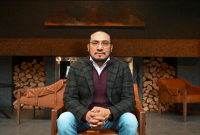Support strong Canadian climate journalism for 2025
Days before Kwakiutl master carver Stan C. Hunt’s latest work began its ceremonial journey, his granddaughter Jade stepped up to the massive cedar artwork.
Gently reaching out to one of the many faces adorning the totem, the six-year-old closed her eyes and stilled herself — in silent communion with her grandfather’s memorial to residential school children.
Nearly 20 feet tall and four feet across, the monument has a large raven with a massive wingspan perched on top, gazing down on 130 individually carved faces representing the thousands of Indigenous children who suffered residential schools, with many never coming home.
His granddaughter’s interaction with the memorial was powerful, said Hunt, adding Jade has some individual struggles of her own.
“She doesn’t hardly talk. She did that on her own,” he said, saying he’s never told Jade what the monument means.
“She just walked up and stood there for well over a minute with her eyes closed,” Hunt said.
“It’s like they communicated. That she felt something we didn’t see.”

Hunt began the memorial as a response to the Tk'emlúps te Secwépemc First Nation’s 2021 announcement that as many as 215 Indigenous children were buried on the grounds of the former Kamloops Indian Residential School.
On Friday, the monument began a tour south down Vancouver Island with stops in Port Hardy, Campbell River, Gold River and Nanaimo before arriving in Victoria on Tuesday.
A ceremony to mark National Indigenous Peoples Day will take place Wednesday morning at Victoria’s Inner Harbour before the Canadian Coast Guard, RCMP and Canadian Navy escort the monument, artist, other carvers and singers by hovercraft to Vancouver’s Canada Place in the afternoon.
After a week’s break, Hunt and his team will begin planning the memorial’s journey into B.C.’s Interior.
“We’re definitely going to Kamloops,” he said.
“We really feel it’s necessary because that's where the truth came out and where it all started.”
The monument was carved with the help of his nephew and apprentice Rey Dickie and Merv Child, an internationally renowned carver in his own right, and with the financial backing of friend and businessman Ray Bergen, Hunt said.

The raven and children’s faces washed in black to represent Canada’s dark history with Indigenous people, Hunt said.
Their faces are framed by orange, the only colour on the memorial, representing the Every Child Matters movement.
“If you look closely, you'll see all those little children's faces, and none of them are happy,” Hunt said.
“They all have their own degrees of grief.”
There’s also an upside-down cross at the pole’s centre engraved with a maple leaf, and the initials of the RCMP and North-West Mounted Police, which are all also inverted.
The raven, the Creator in Kwagiulth culture, is looking down at the institutions that played a role in the murder of Indigenous children, Hunt said.
“It’s going to be hard to hear, but it is the truth,” he said.
“I didn't write this history but I’m marking it.”
It’s a truth that’s no longer secret and needs to be recognized, he stressed.
But the opportunity for reconciliation is depicted in the memorial as well.
The raven is a trickster, Hunt said, and has the seed of life clutched in its beak while looking down the memorial pole upon the forces that devised residential schools.
“But from his point of view, he sees the cross and all the participants right side up,” he said.
“Raven’s going to help us make sense of this and find out if there’s any way we can make it right.”

Rochelle Baker / Local Journalism Initiative / Canada’s National Observer






Comments